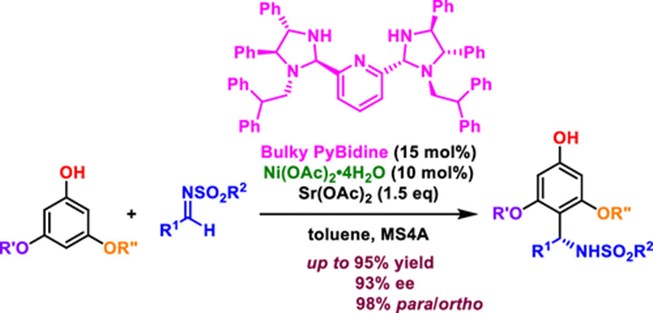A novel bulky PyBidine-Ni(OAc)2 catalyst enables the substitution of imines to the para-position of phenol rings
Selective addition of substituents to specific positions in organic compounds has been instrumental in producing a wide range of products. In a groundbreaking study, scientists from Chiba University, Japan, introduced a novel catalyst called bulky PyBidine-Ni(OAc)2 for the aza-Friedel−Crafts reaction of phenols with imines. The catalyst preferably generates para-substituted products instead of conventional ortho-substituted products, considerably expanding the possibilities for synthesizing novel compounds.

Image Title: Switching the regioselectivity from ortho– to para-selectivity in the aza-Friedel−Crafts reaction.
Image Caption: An innovative bulky PyBidine-Ni(OAc)2 catalyst developed by Chiba University researchers expands the scope of aza-Friedel−Crafts reactions by favoring the production of para-substituted products over the conventional ortho-substituted products, opening new possibilities for generating a wide variety of novel compounds.
Image Credit: ACS Catalysis
Image Link: https://pubs.acs.org/doi/10.1021/acscatal.3c01961
License Type: CC BY 4.0
From life-saving drugs and synthetic polymers to diverse advanced materials, the products containing organic compounds seem endless, thanks in part to regioselectivity, a feature in chemical reactions where a substituent is selectively added to a specific position of an organic compound. This favors the formation of desired products with specific functionalities. One notable regioselective reaction used for the precise design of organic compounds is the Friedel−Crafts reaction, which enables the addition of substituents to specific positions on aromatic compounds such as benzene and phenol rings.
In the traditional acid-catalyzed aza-Friedel−Crafts reaction of phenols with imines, the substitution reaction typically occurs adjacent to the hydroxy (–OH) group of the phenol ring. This leads to the formation of ortho-products such as α-aminobenzylphenols, which hold significant importance in the production of agrochemicals and pharmaceuticals. However, achieving selective substitution at the para-position further away from –OH is challenging and has only been observed for a few substrates.
In a new study published in the journal ACS Catalysis on July 03, 2023, Professor Takayoshi Arai from the Graduate School of Science at Chiba University in Japan, along with Masters’ students, Mr. Ryoya Tajima and Mr. Takaaki Saito, has made a significant breakthrough by developing a general para-selective aza-Friedel−Crafts type reaction of phenols with imines. Their work has opened up new possibilities for the rapid and safe synthesis of medicines and advanced materials. “There has been no general way to achieve a para-selective aza-Friedel−Crafts reaction of phenols until now,” says Prof. Arai, highlighting the novelty of the present work.
In the traditional aza-Friedel−Crafts reaction, ortho-products are formed in the presence of a Lewis acid catalyst. The challenge faced by the researchers was to steer the reaction towards favoring para-substituted products. To solve this issue, they took inspiration from their earlier experiments, in which they had observed that the bis(imidazolidine) pyridine (PyBidine)-metal complex platform had the potential to carry out the aza-Friedel−Crafts reaction of phenols with imines due to its ability to function both as an acid and a basic catalyst.
In a series of tests, the researchers found in their present work that the PyBidine-Ni(OAc)2 complex showed a preference for para-substituted products. They then replaced the benzyl substituent of PyBidine with a bulky diphenylethyl group to obtain a “bulky PyBidine”-Ni(OAc)2 catalyst, which facilitated highly para-selective aza-Friedel-Crafts reactions with up to 99:1 para/ortho selectivity. Furthermore, 3,5-dialkoxyphenols with various sulfonylaldimines yielded para-substituted products—with up to 93% enantiomeric excess (chiral purity)—in the presence of a Sr(OAc)2 additive.
By employing DFT calculations, the researchers found that this regioselectivity was due to a cooperative activation of the highest occupied molecular orbital (HOMO) of 3,5-dialkoxyphenols and the lowest unoccupied molecular orbital (LUMO) of sulfonylaldimines. The reaction began with the formation of a nickel phenoxide, which enhanced the reactivity at the para-position of the phenol group in a process called HOMO activation. The sulfonylaldimine was then attached to this position via hydrogen bonds on the bulky PyBidine-Ni(OAc)2 catalyst through LUMO activation, resulting in the formation of the final product.
This HOMO–LUMO activation was the key to switching the regioselectivity for the design and development of functional molecules for medicines, agrochemicals, and other materials.
In effect, this study is a significant step in the field of regioselective reactions for future applications in various industries. “The rapid and safe synthesis method has improved the synthetic efficiency of an orexin antagonist and is expected to contribute to an environmentally benign and sustainable chemistry,” concludes a hopeful Prof. Arai.
About Professor Takayoshi Arai
Dr. Takayoshi Arai is a Professor at the Department of Chemistry at the Graduate School of Sciences at Chiba University. His research focuses on the development of new compounds and catalysts with specific functionalities and novel synthesis of known organic compounds for various applications, contributing to the advancements in catalysis and enantioselective synthesis. He has published around 170 research articles, which have been cited nearly 10,000 times.
Reference
Title of original paper: Asymmetric para-Selective aza-Friedel−Crafts Reaction of Phenols Catalyzed by Bulky PyBidine-Ni(OAc)2
Authors: Ryoya Tajima, Takaaki Saito, and Takayoshi Arai
Affiliation(s): Soft Molecular Activation Research Center (SMARC), Chiba Iodine Resource Innovation Center (CIRIC), Synthetic Organic Chemistry, Department of Chemistry, Graduate School of Science, Chiba University
Journal: ACS Catalysis
DOI: 10.1021/acscatal.3c01961
Contact:
Takayoshi ARAI
Graduate School of Science, Chiba University
Address: 1-33 Yayoi, Inage, Chiba 263-8522 JAPAN
Email: tarai@faculty.chiba-u.jp
Public Relations Office, Chiba University
Address: 1-33 Yayoi, Inage, Chiba 263-8522 JAPAN
Email: koho-press@chiba-u.jp
Tel: +81-43-290-2018
Recommend
-

The Global Goal of Carbon Neutrality by 2050 (Part 1): Universities as Agents of Change
2023.07.12
-

‘Synergistic Campus Evolution with the Community’ Chiba University Design Research Institute (Part 1): The Entire Campus as a ‘Design Experiment Space’
2023.12.21
-

Creating a Captivating Play Area for Kids: Inspiring Creativity through Innovative Play Equipment Design
2024.01.17


